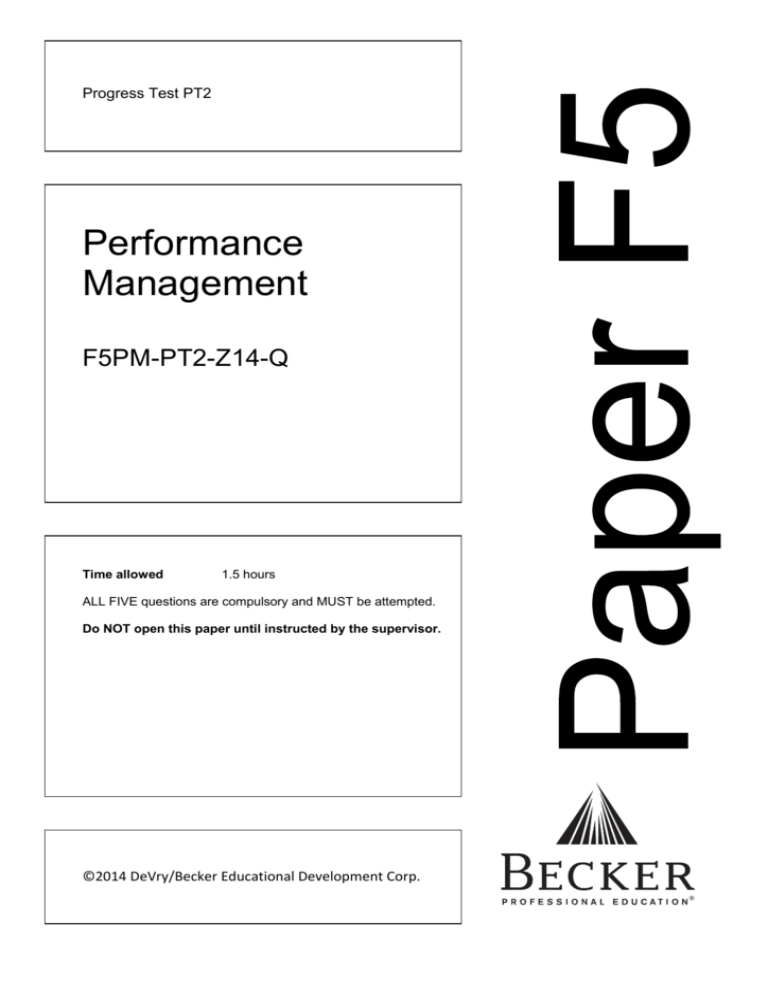
Progress Test PT2
Performance
Management
F5PM-PT2-Z14-Q
Time allowed
1.5 hours
ALL FIVE questions are compulsory and MUST be attempted.
Do NOT open this paper until instructed by the supervisor.
©2014 DeVry/Becker Educational Development Corp. ®
ALL FIVE questions are compulsory and MUST be attempted.
1
(a)
Explain four benefits that would result from the introduction of a budgeting
system by a company.
(8 marks)
(b)
Explain the following approaches to budget setting and give two advantages of
each approach.
(i)
(ii)
a “top down” (or imposed) approach; and
a “bottom up” (or participative) approach.
(6 marks)
(14 marks)
2
Krol Co uses a standard costing system to control its costs. In the most recent month its cost
accountant has reported a large adverse direct material usage variance. An initial investigation
has shown that a faulty machine causes the variance.
The production manager is trying to decide whether to close down the production line for one
day to allow engineers to perform emergency maintenance work that could rectify the
problem. Past experience of investigating raw material usage variances suggests that there is a
70% chance of correcting the fault. If the emergency maintenance work is not carried out now
it is estimated that extra material costs of $60,000 per month for the next six months will be
incurred. After this time the problem will definitely be corrected by scheduled maintenance
work during the company’s annual shut down.
Two maintenance engineers would be required to carry out the emergency maintenance work.
Maintenance engineers are paid $25,000 per annum and each engineer works for 250 days
each year. There is currently surplus capacity in the maintenance department. The emergency
maintenance would use parts costing $10,000. These parts would have to be replaced again
during the scheduled annual maintenance. Emergency maintenance would involve stopping
production for a day resulting in lost production with an estimated sales value of $160,000,
direct material cost of $45,000 and direct labour cost of $90,000. Direct labour would
continue to be paid during the one-day stoppage. In this time the otherwise idle labour would
be used to repaint the factory, saving $7,000 in outside painting contractor costs. Krol carries
no finished goods stocks and is currently unable to satisfy demand for its product.
Required:
Using relevant cost principles, calculate whether the emergency maintenance should be
performed.
(8 marks)
©2014 DeVry/Becker Educational Development Corp. All rights reserved.
2
3
Bob has developed a new car, which will be produced using mass production processes in its
factory. Bob has estimated that the time taken for the first car will be 10 hours. Bob expects
an 80% learning rate to apply for the first 30 cars.
The learning curve can be expressed by an equation of the form
Where
y = axb
y = average time per unit
a = cost of first unit
x = total number of units produced
b = learning factor (log LR/log 2) = -0.322
Calculate the cost per unit of the 30th car.
(6 marks)
4
Despard Ltd manufactures and sells a single product. The following data have been extracted
from the current year’s budget:
Sales and production (units)
Variable cost per unit
Fixed cost per unit
Contribution to sales ratio
5,000
$50
$70
75%
The selling price per unit for next year is to be 8% above the current year’s budgeted figure,
whereas both the variable cost per unit and the total fixed costs are forecast to increase by
12% above their budgeted level in the current year.
The target for next year is that total profit should remain the same as that budgeted for the
current year.
Required:
(a)
Calculate for the CURRENT YEAR the budgeted:
(i)
(ii)
(b)
contribution per unit;
total profit.
(4 marks)
Calculate the number of units which the company should produce and sell next
year in order to achieve the target level of profit.
(6 marks)
(10 marks)
©2014 DeVry/Becker Educational Development Corp. All rights reserved.
3
5
The Aelred Co supplies specialist office stationery to regular customers. Currently all
overheads are charged equally to each order, based on budgeted volumes.
An analysis of overhead expenses has shown that certain costs vary greatly between orders.
The directors have asked for a comparison of typical orders using the current method of
allocating overheads and using a simple activity-based costing system.
The following results have been obtained from the overhead analysis.
Invoice costs
Packing costs
Delivery costs
Other costs
Total overheads
$000
320
215
125
280
––––
940
––––
Cost driver
Number of lines on invoice-note 1
Size of package - note 2
Distance delivered - note 3
Volume of orders - note 4
Notes
The overhead analysis has revealed the following information.
1.
There are 16,000 invoice lines per year.
2.
Packaging costs have been categorised into large packages that cost $15 and small
packages that cost $9.
3.
Couriers charge for delivery based on size of package and distance to destination, as
shown in the following table.
Less than 10 km 11-50 km More than 50 km
$8
$20
$50
$15
$35
$75
Small
Large
4.
There are 4,000 orders per year.
Details of two typical orders are given below:
Order A
2
small
9 km
Lines on invoice
Sizes
Delivery distance
Order B
8
large
150 km
Required:
Calculate the costs for Order A and Order B using:
(a)
the current volume-based allocation system;
(b)
the simple activity-based costing system.
(2 marks)
(10 marks)
(12 marks)
©2014 DeVry/Becker Educational Development Corp. All rights reserved.
4
Formulae Sheet
Learning curve
y = axb
Where
y = average cost per batch
a = cost of first batch
x = total number of batches produced
b = learning factor (log LR/log 2)
LR = the learning rate as a decimal
Demand curve
P = a – bQ
b=
change in price
change in quality
a = price when Q = 0
End of Question Paper
©2014 DeVry/Becker Educational Development Corp. All rights reserved.
5












